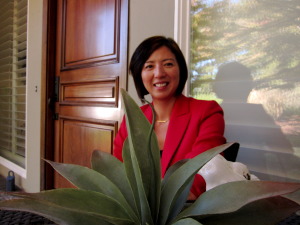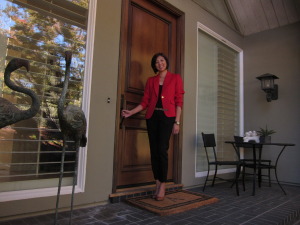By Sharon Simonson

Immigrants to this country who have become U.S. citizens are driving the Bay Area housing market, owning their homes at rates as much as 13 percentage points higher than the American-born, according to new U.S. Census Bureau estimates for 2013.
In Santa Clara County, that coincides with foreign-born citizens’ greater representation in management, business, science, and art occupations and with an outsized presence in manufacturing industries. It also matches with a greater likelihood of living in a bigger house and a higher median household income—$97,000 for foreign-born U.S. citizens versus $91,325 for the U.S.-born.
In San Francisco, not quite half of households of foreign-born U.S. citizens own and occupy their own homes compared to 35 percent of U.S.-born citizens, the largest gap between the two groups among Santa Clara, San Mateo, Alameda and San Francisco counties. It is also a widening gap, with the U.S.-born becoming less likely to own and occupy a San Francisco home in the last five years, while foreign-born citizens have maintained their ownership rate.
The foreign-born make up about a third of the population in the four counties, or 1.7 million people total, including both foreign-born U.S. citizens and non-U.S. citizens here legally and illegally. Nationally, 13 percent of the population is foreign-born, or not quite 41 million people, a record numeric high.
The Bay Area proportion of foreign-born residents—slightly lower in Alameda County at 31 percent, higher in San Mateo and San Francisco counties at 34 percent and 36 percent respectively, and highest in Santa Clara County at 37.4 percent—has held broadly constant since 2007, growing in line with the overall population.
But immigrants living in the region who gain their U.S. citizenship—about half of the foreign-born population—buy family homes at rates higher than their American-born peers—and, even a third of non-citizen immigrants own and occupy their U.S. homes.
“The bigger the house the better,” said Trang Dunlap, a top-producing San Francisco and East Bay agent who co-hosts the weekly “Real Estate Roundtable” radio show at 1550 A.M.
Foreign-born buyers constitute more than half of her business, Dunlop said, though she does not target the foreign-born population in her marketing. Dunlop speaks Vietnamese and is of Vietnamese heritage. “The California bedroom, or a bedroom and a full bathroom on the main level, is one of their (foreign-buyers’) search criteria,” she said. “Some of my clients won’t even look at a house if it doesn’t have that.”
Grace Tsang (pictured above), a broker associate for Intero Real Estate Services in the South Bay, said 80 percent of the buyers she has worked with this year were born outside the United States, primarily in China and India. A Hong Kong native who came to the United States in the 1990s at age 19, Tsang says her understanding of Chinese and American cultures, including Mandarin, Cantonese and English proficiency, has been an unexpectedly powerful marketplace advantage.
A tech-industry alumna who became a Realtor three years ago after earning a master’s degree in business, she has partnered with long-term valley Realtors seeking help with Chinese-speaking clients. The seasoned agents show her the ropes while she translates language and navigates evolving cultural nuance.

Foreign buyers gravitate to the South Bay, the Peninsula or the city based on their lifestyle needs and wants, which often relate to their life-stage and occupation, said Amelia Wong, another Intero agent. San Francisco attracts financial industry and business professionals, college students, restaurant owners and people who have family already living in the city. San Mateo County buyers encompass those groups as well as professionals in the biotechnology industry.
Three of four foreign-born residents in San Francisco are attending college or graduate school, according to the census numbers. That compares to 45 percent of the city’s American-born residents. At the same time, 64 percent of the city’s American-born population has a bachelor’s or a master’s degree compared with 37 percent of the foreign-born.
In her experience, up to 90 percent of the people attending South Bay open houses for for-sale homes are foreign-born or international buyers, Wong said. Conversely, especially in central Silicon Valley cities such as Cupertino, Sunnyvale, Mountain View, Fremont, Milpitas and portions of San Jose, the preponderance of sellers are U.S.-born citizens who have occupied their homes for decades and are retiring or downsizing.
The buyers are chiefly high-tech professionals able to pay $600,000 to $1.5 million or more for their homes. “If the house is in a desirable school district, buyers bid up the asking prices anywhere from $50,000 to $200,000 depending on the location,” she said.
The San Francisco housing stock is the oldest by far in the Bay Area, with not quite half built before 1940, while 20 percent of Alameda County homes were built in the same time period. The ubiquitous ranch home or California “rambler” that characterizes Santa Clara County and to some extent San Mateo County is the product of three mid-century decades of abundant single-family housing production beginning in 1950 and ending in 1980.
Besides the universal embrace of the area’s climate and Silicon Valley’s professional opportunities, international and foreign-born citizens like the region’s popular diversity, variety of international foods at markets and restaurants, and they even (mostly) embrace the ranch house, despite its quintessential American roots and being.
Still, Chinese buyers’ preferences are evolving, Tsang said. “I see a shift away from very high-pressure schools,” she said. Cupertino is no longer an automatic choice. Some parents say they want a more “American childhood” for their children “because they know what a pressure cooker it is back home.” Queried about school choice, one Chinese mother recently told her, “‘I want my son to be happy,’” Tsang said.
In Alameda and Santa Clara County the rates of homeownership across the board have fallen the same amount—about 5 percentage points—since 2008. In Alameda County today, not quite 53 percent of American-born households own and occupy their homes compared to 64 percent among naturalized U.S. citizens. In Santa Clara County, foreign-born citizens occupied 165,000 housing units and owned 67 percent of them. The U.S.-born occupied 340,355 homes and owned 61 percent of them.
(Photos by Sharon Simonson.)
If immigrants are driving the Bay Area housing market, it should follow that they’re driving a lot of other Bay Area consumer markets as well…